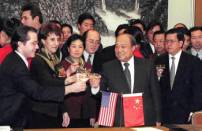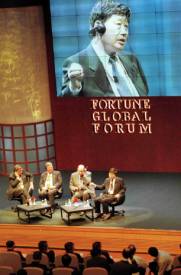|
|
|
OPENING
TO THE OUTSIDE WORLD
|
|
Foreign
Trade
Opening to the outside world has
greatly promoted the development of China??s foreign trade. China??s
import and export volume increased from 1.13 billion US dollars-worth
in 1950 to 360.65 billion US dollars-worth in 1999, or an increase
of 319 times. The total import and export volume in 1999 increased
by 17.5 times, as compared with that in 1978. In terms of foreign
trade, China ranked 32nd in the world in 1978, and rose to ninth
in 1999
Over the past 21 years, great
changes have taken place in China??s import and export trade. First,
the structure of import and export commodities has been constantly
improved. The export volume of primary products, with food, agricultural
and sideline products, and crude oil as the mainstay, has been reduced
by a large margin??from 53.5 percent of the total export volume in
1978 to 10.2 percent in 1999; and the proportion of industrial products
increased from 46.5 percent in 1978 to 89.8 percent in 1999. Remarkable
progress has been achieved in the export of machinery and electrical
products, rising from 1.41 billion US dollars-worth in 1980 to 77
billion US dollars-worth in 1999. Second, foreign-invested enterprises,
which grew from nothing, have become new factors contributing to
the growth of China??s foreign trade. In 1981, the export volume
of foreign-invested enterprises made up 0.1 percent of China??s total
export volume, and 0.5 percent of the import volume. By 1999, the
export volume of foreign-invested enterprises made up 45.5 percent
of China??s total, and the import volume, 51.8 percent. Third, China??s
international trade market is becoming more diversified. In 1980,
nearly 180 countries and regions had trade exchanges with China,
a figure which rose to 228 in 1999. In 1999, along with the recovery
of the Asian economy, China??s exports to other Asian countries restored
growth, and its exports to North America, Europe, Oceanic and Africa
constantly grew. Fourth, foreign trade has been expanded through
various flexible trading forms. Processing trade and small-scale
border trade have increased by a large margin. A situation in which
ordinary trade, processing and assembling with supplied or imported
materials, and small-scale border trade are competing with each
other for development has been formed.
|

On
Nov. 15, 1999,
Shi Guangsheng, Minister
of Foreign Trade, and xx,
American trade representative,
signed the agreement for
China's entry of WTO.

On
Sep. 28, 1999, the '99
Fortune Forum was held in
Shanghai with over 800
participants from
different countries

The
Beijing Automobile Fair
|
|
While running the special economic
zones, China has undertaken a series of reforms in the foreign trade
system, such as expanding local governments?? examination and approval
authority over foreign trade and exports, and enlarging foreign
trade enterprises* autonomy over export trade and operations. Consequently,
the old system featuring monopolized operation by the state, highly
centralized management, integration of government administration
with enterprise operations and the state assuming responsibility
for profits and losses has basically been changed: The state has
gradually cut back on mandatory plans for foreign trade enterprises,
and a management system which indirectly regulates and controls
foreign trade through Customs duties, foreign exchange rates, credits
and tax refunds has been put in place step by step.
In 1986 China formally applied
for reinstatement as a signatory state in the General Agreement
on Tariffs and Trade (GATT), so as to make its foreign trade conform
more to international practice. Since the World Trade Organization
(WTO) was founded in 1995, China continually applied to participate
in it. During this period, China lowered its import tariff rates
on several occasions and realized the convertibility of RMB in regular
items. Over the past 14 years, China??s enthusiasm for acceding to
the WTO has never flagged and it has put its commitments into practice.
That is to say, with its status as a developing country as the premise
and the Uruguay round of negotiations as the basis, China undertakes
its obligations suitable to its economic development level, actively
strengthens negotiations with the United States, European Union
and other member states. Bilateral and multilateral negotiations
for China??s entry into the WTO have reached the final stage. The
day for China to join the WTO is not far away. Meanwhile, China
actively participates in the activities sponsored by the Asian-Pacific
Economic Cooperation Organization, and plays an important role in
the organization. The bilateral trade relations between China and
the United States, the European Union, Russia and Japan have been
constantly strengthened.
|
|



